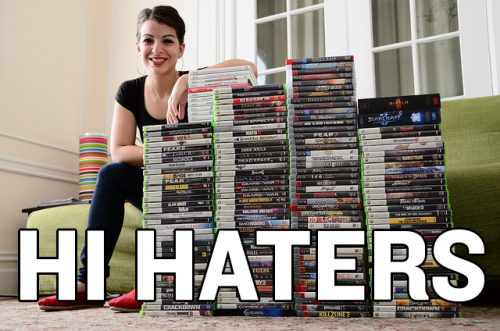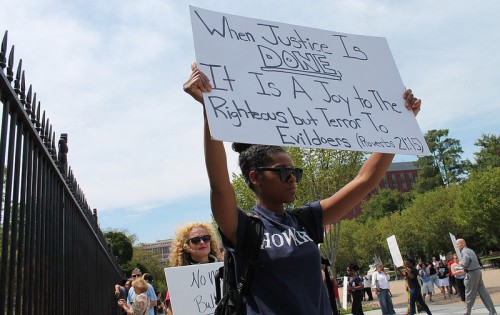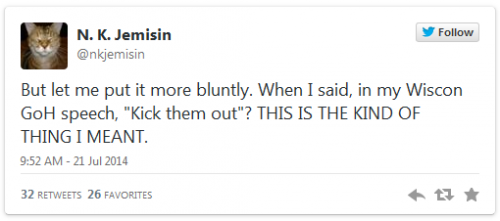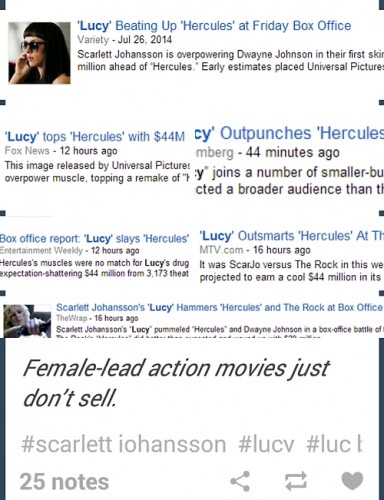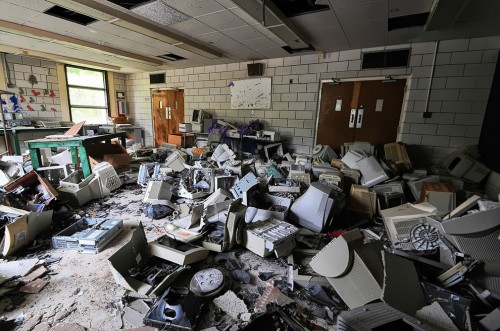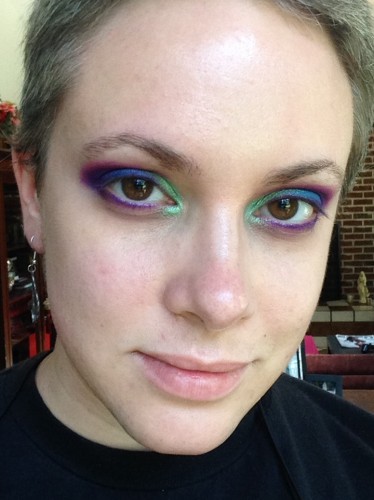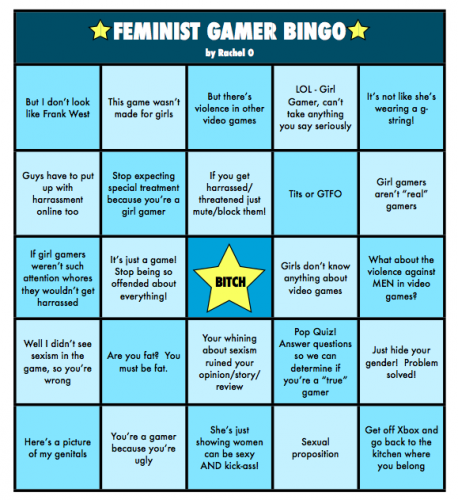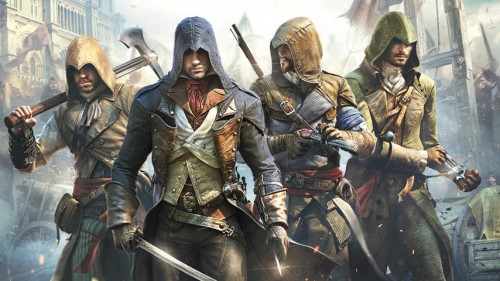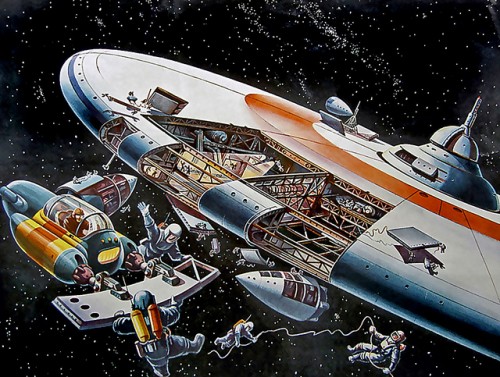I had a lot of thoughts, watching the ugliness that’s been going down regarding what people perhaps misleadingly refer to as the “game community”, but my primary one was probably just “well, this sure is familiar.”
That might be easy to miss in some of how it’s been talked about: we’ve seen this before, and it’s not uncommon. This kind of cultural toxicity is a sort of ever-present background radiation that sometimes spikes into greater visibility, but something I’ve seen a number of trans and queer folks and people of color saying is Slurs and smears and threats to your personal safety? Yeah, welcome to most of our lives. This isn’t at all to minimize the horror of what Anita Sarkeesian and Zoe Quinn have been going through but to point out that for some categories of identity this kind of thing is often normalized into invisibility.
What’s happening to @femfreq happened to @ZerlinaMaxwell & @AngryBlackLady & @shanley & me & a dozen others. Stop acting brand new.
— Mikki Kendall (@Karnythia) August 29, 2014
The specific bell that chimed for me, that mark of familiarity, was struck because of what I’ve seen in the science fiction and fantasy community in the past couple of years. Which is essentially the same thing: slurs, smears, harassment and threats of violence, and – perhaps most fundamentally – the questioning of the right of anyone not white and straight and cisgender male to be in these creative spaces at all. Meditating on this business sent me back to N.K. Jemisin’s fantastic Guest of Honor speech at this past WisCon, where she describes the same exact phenomenon:
How many of you have heard that epic fantasy or video games set in medieval Europe need not include people of color because there weren’t any? I love the Medieval PoC blog for introducing simple visual evidence of how people like me were systematically and literally excised from history. The result is a fantasy readership that will defend to the death the idea that dragons belong and Those People don’t.
Incidentally, the person who runs the Medieval PoC blog estimates she has received something on the order of 30 death threats in recent months.
And let’s talk about the threats — including the ones I’m likely to get for this speech. The harassment. The rapes. The child abuse. Let’s talk about how many conventions have been forced to use disturbingly careful language to basically say, Don’t assault people. Let’s talk about how much pushback statements like that have gotten from people whining, “Aw, c’mon, can’t I assault someone just a little?”
I think one could draw a number of parallels between these two groups and the behavior we’re seeing – and indeed, “geek culture” (whatever that means, exactly) creates a degree of overlap. In considering how to approach this, I thought a lot about gender – how could you not – and some of my background in military sociology and what Lieutenant Colonel Karen O. Dunivan has called the “Combat-Masculine Warrior Paradigm”, which is essentially the cultural construction of a soldier and what it means to be a soldier and how the identity of Soldier is inextricably linked to masculinity (though as Kameron Hurley points out in her Hugo-winning essay, women have always fought).
But I can’t get away from the feeling that that approach is at once too obvious and majorly insufficient. Of course video games and gaming have been and still are gendered masculine, despite the fact that female-identified gamers over 18 now make up the majority of the gamer population. And of course SF&F has been subject to the same processes of gendering, despite the fact that women have always been present and have always been fighting to make genre more inclusive. And of course men and boys will often react poorly to what they see as encroachment by a collection of feminine interlopers preparing to make what they love less awesome. Of course people are generally afraid of what they perceive as change. We all know that, or we should.
So what else is going on? We should expect to see ugliness, sure; it’s everywhere in culture. But why is that ugliness so particularly vicious here?
I don’t think you can boil it down to any one reason. But a number of things came together for me that I believe offer at least a partial explanation.
What many people have noticed in a lot of the misogyny flying around isn’t just hatred but a deep-seated resentment, a sense of festering injury. These guys appear to feel like they’ve been hurt by Anita Sarkeesian, that people like her are trying to take something away from them. I started thinking about this in connection to the various ‘isms that have been rearing their heads in SF&F, and I ended up at the idea of a defiant community.
To clarify: lol nerds
Although science fiction and fantasy – and now gaming of all kinds – have always permeated popular culture, people who are obviously SF&F fans have not historically been constructed in particularly flattering lights. Given the amount of geek culture crossover here, I think one could generalize this to an admittedly oversimplified idea of “gamer”. These are communities – sometimes loose, sometimes extraordinarily tightly-knit – who not only build themselves out of mutual entrainment on a devotional collection of cultural objects but on the defiant embrace of an outcast identity. We’re the weirdos and the freaks and the nerds and the secret is that we’re actually cooler than everyone else. I think this is especially true of people who fell into these cultures and communities as teenagers; I remember how important that sense of secret defiance was. It helped keep me going through some difficult times when I felt profoundly alone.
At least for gamers, this is all of diminished practical importance. People may question the legitimacy of video games as anything but time-wasters, and some of us still appear to be mired in the deeply boring BUT ARE GAMES ART debate, but for the most part games and gamers are now culturally normative and not subject to much in the way of marginalization. Yet I think that sense of defiant community remains, and as Matthew S. Burns points out in his excellent discussion of gamers as “consumer-kings”, it’s something on which the industry understands it can literally bank:
Vast troves of media and content are generated about games every day. It’s easy to get lost in considerations of what game does what well, what game looks the best, sounds the best, which game is the most anticipated, which game might give you the most pleasure when it is released. Ranks of community managers answer questions, assuage fears, absorb complaints, and generally work to make the consumer-king feel respected and important. Slogans like “by gamers, for gamers,” or “power to the players” are uttered. And developers, to varying degrees, continually thank and celebrate their “fan communities”…
The flip side of the consumer-king is an exceedingly loyal customer who will spend a ton of money on games one way or another. Even at the height of his righteous anger, he will probably only avoid one or two platforms or publishers out of spite. He might contribute toxicity or otherwise cause real problems for real human beings. But because of the way our system works, his desire to return to the pure happy consumption palace wins out over the other concerns. At the end of the day he puts money into the system by buying games, and that is the bottom line, the most important fact about him. He is a “gamer”.
That last point is especially salient: the most important thing about a gamer is that they spend money on games. That is now the true center of that particular identity. And being a consumer to whom an industry caters through making them feel special and important has an effect on how people think of themselves. If they’re already nursing the feeling – however subtle – that they’re special members of a special group who deserve to choose between fine dishes specially created to their specific taste, the idea that other people might be coming to the table is deeply threatening.
Suddenly they’re not the consumer-kings anymore. Suddenly they’re not the only ones for whom the chefs are cooking.
This is why I find it interesting that I’ve been repeatedly told that I shouldn’t expect games to “cater” to me – and I see that said all the time whenever the subject gets raised. It’s said by people who appear to be generally oblivious to the fact that they’ve been catered to since the birth of the industry itself. Like all privilege, it vanishes under the cloak of normalization.
For some people all this prospect means is annoyance and vague resentment. But for others this is the spectre of the disintegration of their status as consumer royalty. So they don’t just react with annoyance and resentment; this becomes a fight in which no weapon is off-limits. These people – women, trans and queer people, people of color – do not belong here and must be repelled at all costs, because they will destroy what makes us feel special and important. This is a zero-sum conception of community space and identity defined by consumer culture. More for thee is less for me.
Violent anger is, almost without fail, how the privileged react when they perceive that their privilege is being threatened. But this is also about community originally built around wounded egos, and it’s about consumer capitalism and the sense of entitlement that invariably results. Put all of this together in the context of a racist, misogynist culture, and you have a recipe for horrific degrees of harassment and abuse.
It’s especially worth noting that these are often the same guys who accuse marginalized people of playing up their “victimhood”.
So we need to understand this as more than just misogyny. In no respect is it a fluke or an exception to any rule. This is something that naturally results from the precise manner in which the game industry is constructed, and from a long history of identity construction. Understanding it won’t fix it. But ideally it’s one step among many.
Sarah interlopes wildly on Twitter – @dynamicsymmetry

